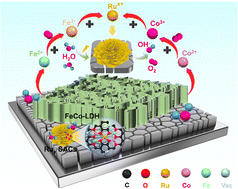Breaking the symmetry of single-atom catalysts enables an extremely low energy barrier and high stability for large-current-density water splitting†
Abstract
The instability and low large-current-density efficiency for a single atomic metal species system have aroused widespread concern. Herein, the Ru single-atom system constructed on an iron–cobalt layered double hydroxide (RuxSACs@FeCo-LDH) exhibits extremely low oxygen evolution reaction (OER) overpotentials of 194 and 246 mV at current densities of 10 and 1000 mA cm−2, respectively, and a high stability greater than 1000 h at 1000 mA cm−2, all of which far surpass the values obtained for commercial RuO2. Moreover, its mass activity is ∼2 and 6 times higher than those of Ru and FeCo-LDH, respectively. Extraordinarily, it only needs 1.52 V to achieve a 1000 mA cm−2 current density for water splitting, and it is almost unchanged after 1000 h, as the highest performance reported so far. Experimental and theoretical calculation results show that, after an activation process, an in situ Ru–O–TM (Fe, Co, and Ni)-like nanocompound is formed on the atom-scale symmetry breaking interfaces of the FeCo-LDH surface, promoting O–O coupling at the Ru–O active sites for OER and beneficial for suppressing multiple heteroatomic interface instability for large-current-density water splitting. Our strategy opens up opportunities for boosting the single-atom stability in industrial-scale hydrogen production from water splitting.



 Please wait while we load your content...
Please wait while we load your content...